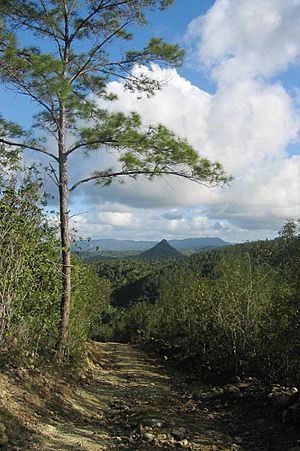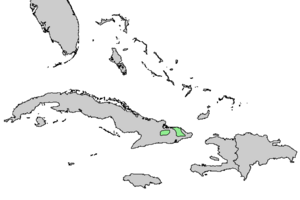Cuban pine facts for kids
Quick facts for kids Cuban pine |
|
|---|---|
 |
|
| Tree near Baracoa, Cuba | |
| Conservation status | |
| Scientific classification | |
| Genus: |
Pinus
|
| Species: |
cubensis
|
 |
|
| Natural range of Pinus cubensis | |
The Cuban pine, also known as Pinus cubensis, is a special type of pine tree. It grows only in the eastern mountains of Cuba. You can find it in the Sierra Nipe-Cristal and Sierra Maestra mountain ranges. This tree is an important part of Cuba's natural environment.
Contents
About the Cuban Pine
The Cuban pine is a tall, evergreen tree. It belongs to the large family of pine trees. These trees are known for their needles and cones. The Cuban pine helps keep the soil healthy in its mountain home. It also provides a home for many animals.
Where the Cuban Pine Lives
The Cuban pine is found only in eastern Cuba. This means it is "endemic" to that area. It grows in the higher parts of the island. These areas include the Sierra Nipe-Cristal and Sierra Maestra mountains. The climate there is perfect for this type of pine.
How Scientists Classify the Cuban Pine
Scientists study plants to understand them better. They group similar plants together. This is called "taxonomy." The Cuban pine (P. cubensis) is closely related to the Hispaniolan pine (P. occidentalis). The Hispaniolan pine grows on the nearby island of Hispaniola.
Some scientists used to think these two pines were the same. But most modern studies now say they are different species. This means they are distinct types of trees.
There is still some discussion about the Cuban pine. The trees in the Sierra Maestra mountains might be a slightly different type. Some scientists think they could be a separate species called P. maestrensis. Others believe they are all part of P. cubensis.
Scientists use genetic studies to learn more. They look at the DNA of the trees. Recent studies show that the pines from Sierra Nipe-Cristal and Sierra Maestra are very similar. They share many of the same genetic traits. This suggests they might have separated into different groups not long ago.
See also
 In Spanish: Pino cubano para niños
In Spanish: Pino cubano para niños


